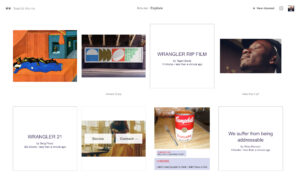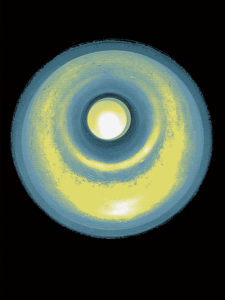Observing Are.na for Design Education: A Case Study
An anarchist medium for weird designers
I have been using Are.na for personal projects for a number of years. It is a unique and compelling digital apparatus — a kind of flatland mind map, freeform research tool and oddball publishing platform all in one. Are.na is also a curious system to behold and to experience (with the best use of Arial anywhere) and it is unlike other “social” media tools like Twitter or Instagram. The platform is owned and run by a community of practitioners, it has no ads, and it encourages lateral thinking across individual channels with the goal of creating a cooperative (instead of distractive) information landscape. It is also funded entirely by members.
As solid and as performant as the overall product is, Are.na also takes genuine time to become acquainted with the general architecture and the way it makes connections, or allows for connections to emerge. In fact, the platform at first feels ephemeral and insubstantial because of its decentralized approach to collating ideas and because of its seemingly madcap mechanics.

Are.na’s simple geometries, however, belie a larger philosophical aspiration of organizing disparate types of online information: images, PDFs, URLs, text, and collections of collections that are both yours and others. (The platform could be labeled communitarian; nothing is truly yours unless you mark it “private” and even then, it is on a decentralized system.)
I have always wanted to use it for teaching design, having seen others employ it over the past year. With classes being fully virtual in the fraught fall of 2020, I thought Are.na would be a perfect tool to inform and accompany the Design Theory and Criticism course I was teaching last semester. I had completely revised my course outline to accommodate the totality of the new digital learning experience: design projects in the course were organized around a Zoom-based classroom, many of the texts that students read were online, and students would read collaboratively in small groups outside of class via video conference. Students would also post their work on the shared learning platform that the entire university used. I wanted this hybrid design studio and seminar course to fully avail itself of this digital “environment”, despite any anticipated failings and frustrations.
During the second week of class, I asked students to use Are.na as a kind of sounding board for ideas that we were studying. I provided a demo of the platform to students and we created a number of thematic areas (e.g. Ethical Design, Bad Typography, Design Authorship, etc.) in Are.na where students could individually add their ideas and research. The loose structure and format of Are.na lends itself to design process work and to student explorations and research — and my hunch was that it would be especially interesting in a class focused on topics of historical and contemporary design theory and criticism.
These early forays mostly worked. Some students responded with interesting contributions to themes but I recognized that many were either avoiding Are.na or not making the time for it, in part owing to the work not being associated with any one project (nor a grade). In fairness, this course has a heavy workload and I should have spent more time training students in how to make the most use of the platform.
For the final project, Are.na was an integral component of the work. Students were asked to develop a set of animated GIFs that illustrated utopian and dystopian internet futures by détournement (or appropriating and altering) a social media-based visual advertisement that they found online (e.g. on Instagram). Students were asked to find an example of a particular schema found in an ad and then change it to represent two potential imaginary digital futures and to build out each one in an animated GIF that is a few seconds in length.
They were also asked present their process work — their ideas and connections to other media — all within Are.na. The final deliverable to be submitted was simply a URL to their public Are.na channel, which would include the two final animated GIFs, their write-ups and the process work that it took to get from A to B.
The project was partly informed by Jaron Lanier’s 2018 book Ten Argument for Deleting Your Social Media Accounts Right Now, which spells out in plain language what technology companies are doing to our minds, souls, and ideas and what these platforms mean for the future of democracy, civil society and public discourse. The project brief started with this:
The internet is making us crazy and yet it is also the most brilliant human invention in history. It has driven huge rifts between us and our communities while allowing us to share our ideas and stories across time and place. It is built to bilk us of our time and money and yet it provides enormous opportunities to help people live better. This project is about creating two visions for the Internet: one positive and one negative via two related animated GIFS. These animations can be deeply personal, critical of the status quo, outrageous or simply funny. But the two animations must represent a cohesive concept for unique futures of the Internet.
As a mechanism to contextually present animations online, Are.na worked. Students focused on crafting their two animated GIFs with an eye toward commenting on internet futures. In the end, the results were solid, thoughtful and coherent and full of the possibilities that all student projects exhibit. While most posted their process work alongside their animated GIFs, they did not have enough time to connect them to other resources on the internet or on Are.na itself. In other words, student presentation of projects was successful — but using the platform for discovery and connection to other online research and information was less so.
However, and perhaps most importantly, the overall class response to using this platform was positive. Most students appreciated using Are.na as a means to simplify and showcase their research and to demonstrate their ideas online. My hope is that they will continue to work on and in Are.na in future design research work. As the move to online education increases, Are.na is a bright (twinned) star in the late dawn of all social sharing platforms.
